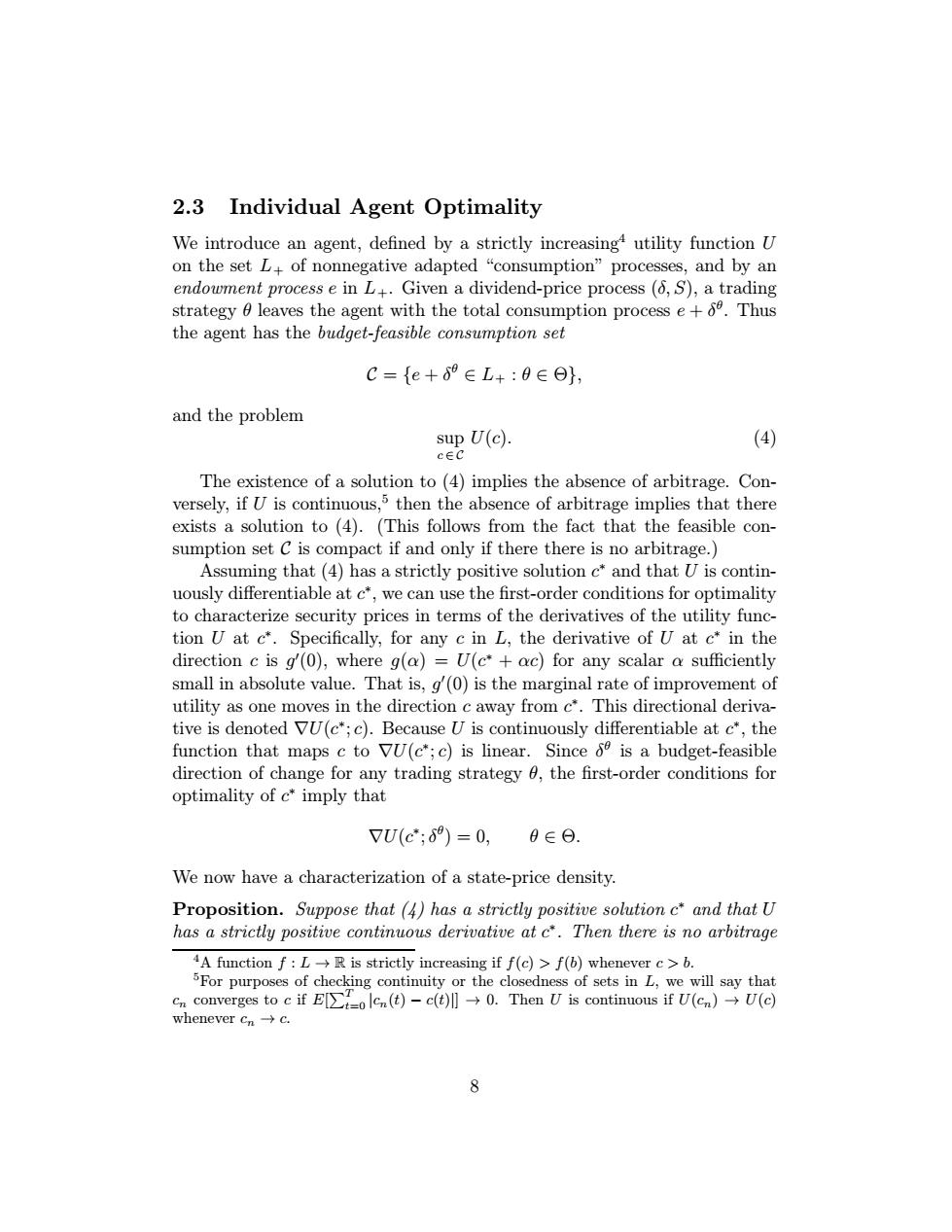正在加载图片...

2.3 Individual Agent Optimality We introduce an agent,defined by a strictly increasing utility function U on the set L+of nonnegative adapted "consumption"processes,and by an endowment process e in L+.Given a dividend-price process(,S),a trading strategy 6 leaves the agent with the total consumption process e+80.Thus the agent has the budget-feasible consumption set C={e+e∈L+:0eΘ}, and the problem sup U(c). (4) c∈C The existence of a solution to (4)implies the absence of arbitrage.Con- versely,if U is continuous,5 then the absence of arbitrage implies that there exists a solution to (4).(This follows from the fact that the feasible con- sumption set C is compact if and only if there there is no arbitrage.) Assuming that (4)has a strictly positive solution c*and that U is contin- uously differentiable at c*,we can use the first-order conditions for optimality to characterize security prices in terms of the derivatives of the utility func- tion U at c*.Specifically,for any c in L,the derivative of U at c*in the direction c is g(0),where g(a)=U(c*+ac)for any scalar a sufficiently small in absolute value.That is,g'(0)is the marginal rate of improvement of utility as one moves in the direction c away from c*.This directional deriva- tive is denoted VU(c*;c).Because U is continuously differentiable at c*,the function that maps c to VU(c";c)is linear.Since 8 is a budget-feasible direction of change for any trading strategy 0,the first-order conditions for optimality of c*imply that 7U(c*:6)=0,0∈日 We now have a characterization of a state-price density. Proposition.Suppose that (4)has a strictly positive solution c*and that U has a strictly positive continuous derivative at c.Then there is no arbitrage 4A function f:LR is strictly increasing if f(c)>f(b)whenever c>b. 5For purposes of checking continuity or the closedness of sets in L,we will say that c.converges to cif E∑f-olcn()-c(t训→0.Then U is continuous if U(c,)→U(c whenever cn→c. 82.3 Individual Agent Optimality We introduce an agent, defined by a strictly increasing4 utility function U on the set L+ of nonnegative adapted “consumption” processes, and by an endowment process e in L+. Given a dividend-price process (δ, S), a trading strategy θ leaves the agent with the total consumption process e + δθ. Thus the agent has the budget-feasible consumption set C = {e + δθ ∈ L+ : θ ∈ Θ}, and the problem sup c ∈ C U(c). (4) The existence of a solution to (4) implies the absence of arbitrage. Conversely, if U is continuous,5 then the absence of arbitrage implies that there exists a solution to (4). (This follows from the fact that the feasible consumption set C is compact if and only if there there is no arbitrage.) Assuming that (4) has a strictly positive solution c∗ and that U is continuously differentiable at c∗, we can use the first-order conditions for optimality to characterize security prices in terms of the derivatives of the utility function U at c∗. Specifically, for any c in L, the derivative of U at c∗ in the direction c is g0 (0), where g(α) = U(c∗ + αc) for any scalar α sufficiently small in absolute value. That is, g0 (0) is the marginal rate of improvement of utility as one moves in the direction c away from c∗. This directional derivative is denoted ∇U(c∗; c). Because U is continuously differentiable at c∗, the function that maps c to ∇U(c∗; c) is linear. Since δθ is a budget-feasible direction of change for any trading strategy θ, the first-order conditions for optimality of c∗ imply that ∇U(c∗ ; δθ )=0, θ ∈ Θ. We now have a characterization of a state-price density. Proposition. Suppose that (4) has a strictly positive solution c∗ and that U has a strictly positive continuous derivative at c∗. Then there is no arbitrage 4A function f : L → R is strictly increasing if f(c) > f(b) whenever c>b. 5For purposes of checking continuity or the closedness of sets in L, we will say that cn converges to c if E[ PT t=0 |cn(t) − c(t)|] → 0. Then U is continuous if U(cn) → U(c) whenever cn → c. 8